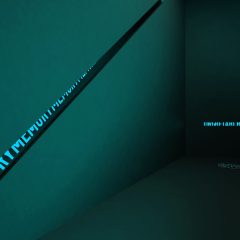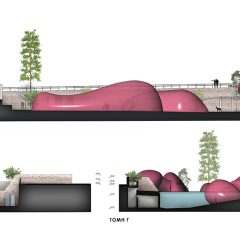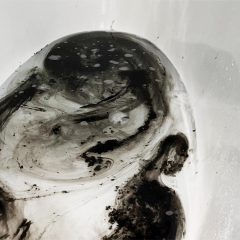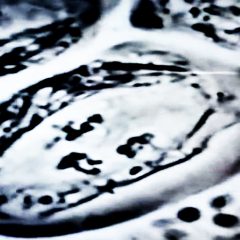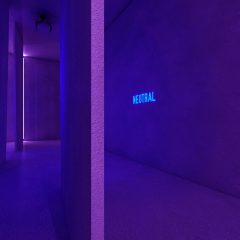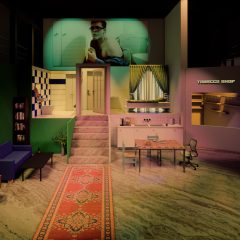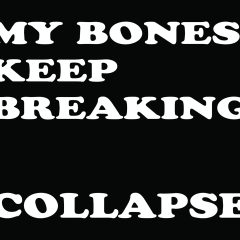General
Scenic Space II course offers an open environment for interdisciplinary exploration in the realms of art, technology and society. The course emphasizes the continuum between physical and virtual spaces, and fosters exploratory work that seeks to exhibit innovative visual and audio expression, along with conceptual clarity and technological skills and insights.
Course content
The course’s projects are covering the following areas:
New Technology on Stage: Explores New Media as the exclusive tools of creating Digital Scenic Environments.
Computer Aided Scenography: Presents audiovisual experimental applications, produced by softwares, involving graphics and effects on the level of an aesthetic elaboration. Explores audiovisual constraction made for the set desgn of contemporary plays.
Expanded Scenography: Explores the emerging agencies and the involving spatial practices, such as artistic, material, theoretical, in a variety of theatrical contexts. It focuses in new kinds of immersive, participatory and mediated enviroments using a number of digital aparatuces.
At the core of the course we come to realise how digital media create new dynamics for a theatrical text -a play- to be experienced by the viewer. Hense, in each class-session we deal with the relevant theory, problems in meaning and communication, identity and signification, conceptual invention and creativity, critical analysis.
Programme aims
Scenic Space II course aims to:
• engage the student in a range of performance languages and skills for conceptualising, researching, developing and executing ideas within a performance context;
• enable the student to develop your skills in framing a practical research project in relation to identified aims and objectives;
• enable the student to operate within a working collective where the transference of shared ideas, skills and discipline perspective is paramount to the process of interdisciplinary innovation;
• make possible student’s understanding of new synergies across disciplines, promoting the evolution of new approaches to the making and structuring of material;
• explore a diverse range of models and techniques for interdisciplinary improvisation within various contexts.
Learning Outcomes: Knowledge and Understanding
In Scenic Space II students will establish their individual area of practice and ascertain the focus of your research project. They will develop their practice in both technical and conceptual terms, in order to indicate their intentions for the next stage of the course. A series of skills based workshops (e.g. sound, light, architecture, text, performance presence and web interfaces) introduce students to a range of performance languages that build upon your prior experience and skills. They will also begin to frame your research enquiry as a foundation for your continued investigation during the course.
On completion of the unit students will be able to:
• Present a collection of artistic outcomes that draw on, and extend or challenge, existing knowledge within your area of specialism (Research, Subject knowledge, Experimentation, Technical competence, Communication and Presentation, Personal and professional development, Collaborative and/or independent professional working)
• Be critically aware of knowledge and understanding of artistic practices and theoretical debates relevant to your performance practice (Research, Analysis, Subject knowledge, Experimentation)
• Frame your aims and objectives for a research project and identify appropriate research questions and methods (Research, Analysis, Subject knowledge, Experimentation, Communication and Presentation, Personal and professional development)
• Engage in a reflective critique of your practice through the use of blogs as an e-journal, where you will encounter debate through the distribution of ideas in an open forum
Bibliography
Auslander, P. (1999). Liveness: Performance in a mediatized culture. London: Routledge.
Barthes, R, (1993), The Rhetoric of Photography, In Image/Music/Text. Glasgow: Fontana Press.
Broadhurst, S. (2007). Digital practices: aesthetic and neuroesthetic approaches to performance and technology. Basingstoke [England]; New York: Palgrave Macmillan.
Bruns, A. (2008). Blogs, Wikipedia, Second Life, and beyond: from production to produsage. New York: Peter Lang.
Burgheim, J, (2016), Live performances in Digital Times: An Overview, IETM Mapping
Causey, M. (2006). Theatre and performance in digital culture: from simulation to embeddedness. London: Routledge.
Cindy, Sherman, (1982) Schirmer / Mosel, Munich.
Davis, E. (1998). Techgnosis: myth, magic + mysticism in the age of information. New York: Three Rivers Press, Random House Inc.
Delgado, M. M., & Svich, C. (2002). Theatre in crisis?: performance manifestos for a new century: Manchester University Press.
Deleuze, G, (2006) “The Schizophrenic and Language: Surface and Depth in Lewis Carroll and Antonin Artaud.” 1969. From Textual Strategies. Ed. Josué V. Harari. Ithaca: Cornell UP, 1979. 277-95. In Structuralism: Critical Concepts in Literary and Cultural Studies. Ed. Jonathan Culler. London: Routledge, Vol. 2.
Dixon, S. (2007). Digital performance: a history of new media in theater, dance, performance art, and installation. Cambridge, Mass.: MIT Press.
Kockelkoren, P. (2003). Technology: art, fairground, and theatre. Rotterdam: NAi Publishers.
Lunenfeld, P. (1999). The digital dialectic: new essays on new media. Cambridge, Mass.: MIT Press.
Manovich, L, (2001) The Language of New Media. Cambridge, MA: MIT Press.
McLuhan, M. (2001). Understanding media: the extensions of man. London: Routledge.
Reaves, J. (1995). Theory and practice: the Gertrude Stein Repertory Theatre. CyberStage, 1(3).
Richardson, J. M. (2012). The blue glow from the back row: Live theater and the wireless teen. English Journal,102(1), 88
Ryan, M.-L. (1999a). Cyberspace textuality: computer technology and literary theory. Bloomington: Indiana University Press.
Salz, D. Z. (2004). Performing arts. In S. eds. Schreibman, R. G. Siemens & J. Unsworth (Eds.), A companion to digital humanities, Malden, MA; Oxford: Blackwell Pub.
Thomas, J, (2000) ed. Reading Images, Palgrave Macmillan.
Zettle, H, (1999), Sight, Sound, Motion, Applied Media Aesthetics, Wadsworth Publishing Company USA.


